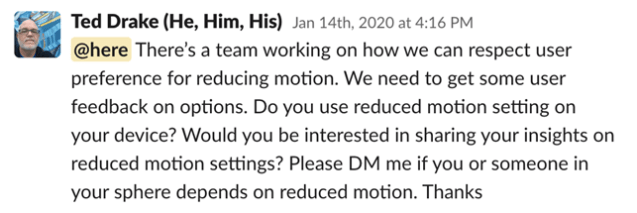As a software designer at Intuit, it’s my responsibility to create products and services that everyone can use, regardless of their level of physical, sensory, or cognitive ability. After all, people depend on Intuit applications to lead independent financial lives, and that kind of empowerment begins with accessibility. I joined Intuit’s Accessibility Champions team (now 1000-members strong) to help fulfill this mission, and to make sure we’re accommodating the needs of all of our customers. And then discovered in the course of my work that I had accessibility needs of my own.
My journey with motion sensitivity began long before I recognized it as such. As a breakdancer, I knew that I had a propensity for dizziness, but I thought it was just my own problem to deal with. At dance practice, windmills would leave me sickly pale with nausea that could last all day.
Me in a cypher at an art event. It may not look like it, but I was dizzy after the first couple swipes (the spinning move with a leg tap at the beginning). After that, I was operating on muscle memory, hopefully still reacting to the music. In the end, you can see me walk to the back to hide my dizziness instead of acknowledging the crowd.
Beyond dancing, I also had issues with many software applications; looking at motion designs like sliding screens and animations can feel like riding a merry-go-round, making me feel dizzy or even nauseous. To try to ease this discomfort and prevent the onset of motion sickness, I got into the habit of turning on reduced motion for each gadget I picked up. On some instinctive level, this small accommodation might have been part of my inspiration for becoming an Intuit Accessibility Champion. But I didn’t realize that I actually had motion sensitivity until Ted Drake, Intuit’s Global Accessibility Leader, asked for feedback from people who use reduced motion.

Ted’s question led me to think about my experiences as they relate to motion, and I realized that I am actually quite sensitive to motion. For example, video games in the first-person perspective often leave me in cold sweats. Virtual reality experiences, while incredible, are nearly as nauseating (though recent rendering techniques to prevent motion sickness have greatly improved the experience).
Despite being an Intuit Accessibility Champion and someone who uses reduced motion, I had completely overlooked accessible motion. I dug into the research to learn more, and it turns out I was hardly alone in my dizziness. In fact, anyone with a functioning vestibular system (part of the inner ear that’s involved with balance) can experience motion sickness. Other factors like lack of sleep, stress, and age can all increase a person’s sensitivity to motion. Symptoms of motion sickness can range from vertigo to nausea to migraines and more, and they often go unrecognized.
Unfortunately, while motion sickness has shown to hinder focus and performance, sufferers are often blamed, or blame themselves, for being unmotivated and apathetic. This can lead to unconscious task abandonment or avoidance, and that’s a problem for businesses. A customer’s motion sensitivity can become a business problem as well. At one point, I decided to choose one real estate app over another simply because the first had too many animations and screen transitions. I didn’t understand my discomfort, only that I was tired of it after 30 seconds. So I moved on to a different company altogether.
In fact, a recent Wall Street Journal article, Web Designers Grapple with Downside to Flashy Animation: Motion Sickness, by Experience Report writer, Katie Deighton, delves into what companies like Intuit are doing to improve user experiences.
Today, it’s become clear that motion design in software isn’t just a matter of decoration or whimsy. Our TurboTax product uses motion as people progress from page to page as a way to retain their attention. In fact, motion can be important for cognitive accessibility. In discussing the issue, our Accessibility Champions team realized that the answer wasn’t to simply remove the animations from our products, but rather, to provide an alternate animation that kept people engaged without making them sick.
With my newfound awareness of motion sensitivity, I was initially consumed with what-if’s and if-only’s—perhaps I’d be a much better dancer were I not so prone to dizziness. Fortunately, Ted continued to reach out with opportunities to audit designs and make recommendations for accessible motion. Being able to apply insight from my “weakness” to improve user experiences began to feel more like a superpower. I think many abilities are gained from disabilities, and they’re simply resources society has yet to figure out how to utilize. But that seems to be changing each day, and I think our work in accessibility is helping facilitate that change.
Today, Intuit designers produce two versions of nearly every animation we create, with a reduced motion option for users who have switched on that setting. I test every one of these designs to make sure they’re meeting the needs of our customers. These efforts benefit not only individuals with classic motion sensitivity, but also people with ADHD (attention deficit/hyperactivity disorder), autism, COVID-related “brain fog,” and other visual processing issues.
It’s honestly a bit surreal to me that Intuit affords anyone in our company—from managers to customer service reps to software engineers—the time and resources to learn about accessibility, and to use this knowledge to improve our products. While I’ve never been at an organization that outright denied the importance of accessibility, there have been places where it didn’t seem important enough to allocate resources. But here, I document and share my learnings and audits, because awareness at Intuit often leads to action. Even as an individual contributor, I can raise my hand and make a difference for our customers.
Even if I never get my windmills down.
To learn more about Intuit’s approach to accessibility, check out this blog on 5 Ways to Engage Employees, Customers and Communities.